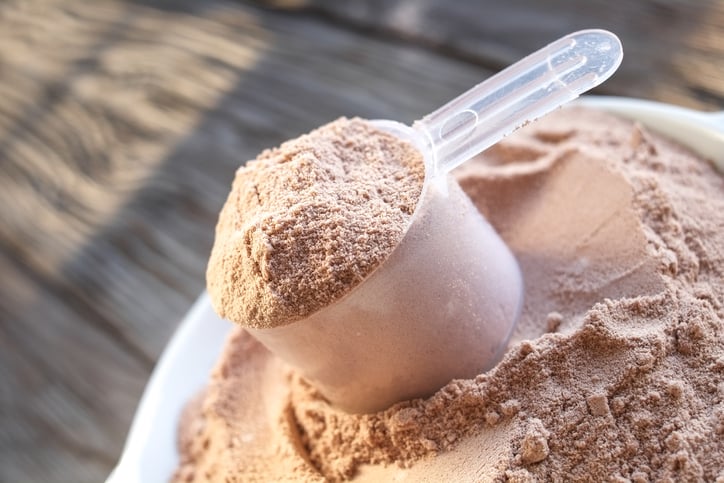7 Ingredients That Should NEVER Be In Your Protein Powder

If you’ve been following our blog, you know one of the most impactful and effective strategies for improving health and nutrition is to consume a higher protein diet. Research shows higher protein diets (and supplementing with protein powders) can help enhance:1,2
- Body composition
- Weight loss
- Weight maintenance
- Appetite management
- Glycemic control
- Metabolic rate
- Sleep
- Healthy aging
- Strength
- Athletic performance
- Recovery from exercise
- And more
When it comes to “how much” protein, recommendations vary based on body composition, size, activity levels, and goals. However, a good starting point is to consume at least 0.7 grams of protein per pound of body weight per day.3 For instance, if you’re 150 pounds, that would mean eating about 105 grams of protein daily.
And while it is possible to get enough protein through whole-food sources, protein powders are a convenient, cost-effective, and practical solution to ensure you’re getting plenty of high-quality protein daily. Not only that, protein powders are typically available in a wide range of flavors, and their utility can be quite versatile. For instance, you can mix them into smoothies, yogurt, oatmeal, baked goods, and more.
But here’s the deal…not all protein supplements are created equal. Not even close, as a matter of fact! Here are some of the top ingredients to watch for—and avoid—in many protein powders.
7 Things You Don’t Want In Your Protein Powders
1. Hormones and Antibiotics
Bovine somatotropin (BST) is a hormone naturally produced in the brains of dairy cows. A genetically engineered recombinant version of BST (rBST or rBGH) was developed and is injected into some cows to boost milk production. Unfortunately, cows treated with rBST are at a greater risk for infection, reduced fertility, and disability. The increased risk for infection leads to increased use of antibiotics, which can contaminate milk and lead to the development of antibiotic-resistant bacteria in humans.
Controversial to say the least, further evidence of the potential danger of these synthetic hormones is they’ve been banned in Europe and several other countries across the globe. For us, finding a protein that’s free from rBST and rBGH is mandatory. Along these lines, animal care is very important to us. That’s why we also suggest making sure you only use a protein powder that comes from happy, healthy, humanely treated cows that have been pasture raised.
2. Artificial Sweeteners and Colors
Artificial sweeteners, such as sucralose, saccharin, aspartame, and acesulfame-K, are often added to protein powders to boost flavor without adding calories. While the rationale seems health-conscious (e.g., reducing calorie intake, helping manage blood sugar levels), emerging evidence suggests the costs may outweigh any potential benefits. Artificial sweeteners have been tied to:4–8
- Gut dysbiosis (the increased growth of bad bacteria in the digestive system)
- Poor carbohydrate tolerance
- Increased hunger
- Weight gain
- Oxidative stress
- Accelerated aging
- Cognitive decline
On top of that, artificial food dyes, made from petroleum and often found in protein powders, are likely carcinogenic. Over the years, many food dyes have been banned because of the adverse health effects shown in studies. The European Union requires food manufacturers to place compulsory warnings on foods containing artificial colors. However, in the US, food dye consumption has increased five-fold since 1955, with three dyes—Red 40, Yellow 5, and Yellow 6—accounting for 90% of the dyes used in foods. These same three food dyes also contain benzidene, a known human carcinogen.910
What’s more, at least four food dyes—including Blue 1, Red 40, Yellow 5, and Yellow 6—have also been found to lead to hypersensitivity reactions.10 While not true food allergies, these are allergy-like reactions that involve an immune response and can lead to a wide range of symptoms (e.g., auto-immune flare-ups, skin inflammation, respiratory inflammation, headaches/migraines, mood issues, brain fog, etc.).
The consumption of artificial food dyes has been linked to hyperactivity, neurotoxicity, and neurobehavioral changes, including low frustration tolerance, impulsivity, and inattention.11,12 In Europe, foods containing artificial colors must carry a mandatory warning stating they “may have effects on activity and attention.”
For all these reasons, we urge you to choose only protein powders made with the finest natural ingredients, void of all artificial ingredients, including artificial sweeteners and colors.
3. GMOs
If you’re looking to stir things up at your next social gathering, bring up one of the following topics: 1. Politics, or 2. GMOs. Arguably one of the more polarizing and highly debated topics in health and nutrition surrounds genetically modified (GM) foods, or genetically modified organisms (GMOs), which are plants or animals created through genetic engineering.
While there are countless concerns on the topic, one of the most relevant is that 80% of all GMOs grown worldwide are engineered to tolerate the toxic herbicide glyphosate (better known as “Roundup®”). Since 1970 when glyphosate was first brought to market, its use has increased 100-fold!13,14 Ironically, one of the proposed benefits of GMOs was that they were supposed to result in less use of toxic herbicides. Not so much.
For example, glyphosate-based herbicides are used on a wide range of GM crops, such as corn soybeans, canola, wheat, barley, and other crops. Testing by the UK-Food Standard Agency and USDA has revealed glyphosate residues in up to 90% of the crop samples. Because of its rampant use in agriculture, researchers have even found glyphosate residues in the air we breathe and the water we drink.
Here’s the deal: Glyphosate is authoritatively classified as a probable human carcinogen.15 This toxic herbicide may also be linked to Alzheimer’s disease, depression, Parkinson’s disease, autism, and other health problems. One group of researchers reported that glyphosate’s “negative impact on the body is insidious and manifests slowly over time as inflammation damages cellular systems throughout the body.”16 Sounds pretty scary…and it is!
That’s exactly why we feel it’s a good idea to choose a protein powder that’s made without any GMO ingredients.
4. Soy
While it still masquerades as a “health food,” soy has been linked to a number of health concerns. Soy contains estrogenic anti-thyroid compounds called isoflavones—which are natural pesticides that cause insects to become sterile—that can have a goitrogenic effect, disrupting the production of thyroid hormone by inhibiting thyroid uptake of iodine and reducing the activity of the enzyme involved in thyroid hormone formation.17,18
And speaking of GMOs, it’s also worth pointing out that nearly all (i.e., ~90%) of the soy grown in the United States is genetically engineered.19 What’s more, soy contains substances that inhibit proteases. These are enzymes that digest the proteins we eat. This can lead to poor digestion and GI distress.
Perhaps most importantly, research has shown that soy is a lower quality, inferior protein (compared to milk-based proteins, such as whey). For instance, one of the most noteworthy benefits of high-protein diets is increased appetite control. Several studies have shown that whey protein is substantially more effective than soy protein when it comes to suppressing appetite, increasing satiety (which refers to feeling full and satisfied), and controlling food intake.20–22
In the long-run, supplementation with soy protein powders has been shown to be inferior to whey protein when it comes to reducing body fat and waist circumference. On top of that, research has also shown that soy protein appears to be a lower quality option when it comes to building calorie-burning lean muscle.23–26
In addition to the above ingredients commonly found in protein supplements, here are a few more to keep a watchful eye out for:
5. Added sugar
“Eat more added sugar,” said no one ever. When consumed in excess, added sugar may contribute to obesity, diabetes, and cardiovascular disease.27
6. Maltodextrin
Although it’s marketed as a “complex” carbohydrate and manufacturers can subsequently tout that their products contain “low-sugar” carbohydrates, the fact is that maltodextrin is a very easily digestible chain of sugar molecules. In fact, it has a higher glycemic index than pure glucose.28
7. Gluten
While it may not be the “avoid-at-all-costs” villain many have made it out to be, gluten really doesn’t have any place in a high-quality protein supplement. However, due to production at “cost cutting” manufacturing facilities, many products are contaminated with gluten. Even worse, some companies dubiously add gluten (as “glutamine peptides”) to their products to (cheaply and inferiorly) pump up the protein content.
So, while protein supplementation is a very good idea, you have to be vigilant when evaluating your options. Fortunately, this is something we’re incredibly passionate about, and we’ve taken all the guesswork out of it for you.






